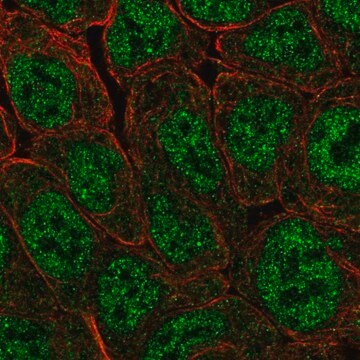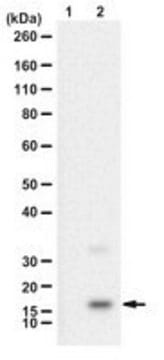推薦產品
生物源
mouse
品質等級
共軛
FITC conjugate
抗體表格
purified antibody
抗體產品種類
primary antibodies
無性繁殖
TRA-1-60, monoclonal
物種活性(以同源性預測)
human (based on 100% sequence homology)
技術
flow cytometry: suitable
immunocytochemistry: suitable
同型
IgM
運輸包裝
wet ice
目標翻譯後修改
unmodified
基因資訊
human ... PODXL(5420)
一般說明
人胚胎性癌(EC)细胞是畸胎癌的干细胞,它们是生殖细胞肿瘤(GCT)的关键组成部分。它们表达几种在分化时被下调的高分子量糖蛋白抗原。可以在GCT患者的血清中检测到由单克隆抗体TRA-1-60定义的这些抗原之一,并且可以为已建立的血清标志物人绒毛膜促性腺激素和α-胎蛋白提供有用的补充,特别是在那些血清人绒毛膜促性腺激素或α-胎蛋白没有升高的患者中。
特異性
该抗体与在人四癌干细胞(EC)、人胚胎生殖细胞(EG)和人胚胎干细胞(ES)表面表达的TRA-1-60抗原反应。
鼠EC、EG或ES细胞未见免疫反应性。 TRA-1-60和TRA-1-81单克隆抗体(MAB4381)均可识别与细胞周围基质蛋白聚糖相关的抗原。TRA-1-60与唾液酸酶敏感表位反应,而TRA-1-81与同一分子的未知表位反应。
鼠EC、EG或ES细胞未见免疫反应性。 TRA-1-60和TRA-1-81单克隆抗体(MAB4381)均可识别与细胞周围基质蛋白聚糖相关的抗原。TRA-1-60与唾液酸酶敏感表位反应,而TRA-1-81与同一分子的未知表位反应。
免疫原
- 对应于TRA-1-60的全细胞。
應用
使用经过验证可用于FC & IC的抗-TRA-1-60 抗体(克隆 TRA-1-60)FITC 偶联物检测TRA-1-60。
固定的H9人ES细胞的免疫细胞化学染色,在 2-8C 下以抗-TRA-1-60 FITC偶联(货号FCMAB115F)单克隆抗体的1:100稀释液培养两小时。 多能人ES细胞对该抗体有强免疫反应。
活H9人ES细胞的免疫细胞化学染色,在37C下以抗-TRA-1-60 FITC偶联(货号FCMAB115F)单克隆抗体的 1:100稀释液培养30分钟。 多能人ES细胞对该抗体有强免疫反应
流式细胞术:
添加抗体进行细胞染色:
5 μl 工作溶液:5 x 105 细胞/ 95 μl PBS100 μl 总反应物体积
10 μl 工作溶液:1 x 106 细胞 / 90 μl PBS 100 μl 总反应物体积
活H9人ES细胞的免疫细胞化学染色,在37C下以抗-TRA-1-60 FITC偶联(货号FCMAB115F)单克隆抗体的 1:100稀释液培养30分钟。 多能人ES细胞对该抗体有强免疫反应
流式细胞术:
添加抗体进行细胞染色:
- 用PBS按1:5的稀释度稀释一抗,制备抗体工作溶液。
- 根据下表所示的细胞数目,分配每次测试的工作溶液体积:
- Guava流式细胞仪 5 L
- 其它流式细胞术设备10 L
5 μl 工作溶液:5 x 105 细胞/ 95 μl PBS100 μl 总反应物体积
10 μl 工作溶液:1 x 106 细胞 / 90 μl PBS 100 μl 总反应物体积
研究子类别
多能&早期分化
多能&早期分化
研究类别
干细胞研究
干细胞研究
標靶描述
~235/410 kDa
外觀
FITC偶联的纯化小鼠单克隆IgM,溶于含有低于0.09%叠氮化钠和15 mg/mL BSA的PBS中。
儲存和穩定性
自收到之日起,以未稀释等分试样避光冷藏于2-8ºC,可保存 6 个月。
分析報告
对照
多能人胚胎干(ES)细胞
多能人胚胎干(ES)细胞
免責聲明
除非我们的产品目录或产品附带的其他公司文档另有说明,否则我们的产品仅供研究使用,不得用于任何其他目的,包括但不限于未经授权的商业用途、体外诊断用途、离体或体内治疗用途或任何类型的消费或应用于人类或动物。
未找到適合的產品?
試用我們的產品選擇工具.
儲存類別代碼
10 - Combustible liquids
水污染物質分類(WGK)
WGK 2
閃點(°F)
Not applicable
閃點(°C)
Not applicable
分析證明 (COA)
輸入產品批次/批號來搜索 分析證明 (COA)。在產品’s標籤上找到批次和批號,寫有 ‘Lot’或‘Batch’.。
Chunbo Yang et al.
Human molecular genetics, 26(16), 3031-3045 (2017-05-19)
Hypoplastic left heart syndrome (HLHS) is among the most severe forms of congenital heart disease. Although the consensus view is that reduced flow through the left heart during development is a key factor in the development of the condition, the
Cathelijn E M Aarts et al.
Stem cell research, 54, 102444-102444 (2021-06-29)
Induced pluripotent stem cells (iPSCs) were generated from blood outgrowth endothelial cells (BOECs) obtained from a healthy donor and from a patient diagnosed with Hermansky Pudlak Syndrome type 2 (HPS2), caused by compound heterozygous AP3B1 mutations (c.177delA and c.1839-1842delTAGA). BOECs
Toshio Miki et al.
Stem cell research & therapy, 7, 8-8 (2016-01-14)
Amnion-derived stem cells have been proposed for cell replacement therapy and tissue regeneration. An easily accessible cell source, the placenta, allows us to potentially establish a bio-bank of cells for immunotype matched clinical applications. Several xeno-free (XF) cryopreservation media are
Irina Neganova et al.
Scientific reports, 7, 41693-41693 (2017-02-06)
Reprogramming of somatic cells to induced pluripotent stem cells (iPSCs) holds enormous promise for regenerative medicine. Reprogramming is a stepwise process with well-defined stages of initiation, maturation and stabilisation which are critically dependent on interactions between key pluripotency transcription factors
Robert J Ihry et al.
Nature medicine, 24(7), 939-946 (2018-06-13)
CRISPR/Cas9 has revolutionized our ability to engineer genomes and conduct genome-wide screens in human cells1-3. Whereas some cell types are amenable to genome engineering, genomes of human pluripotent stem cells (hPSCs) have been difficult to engineer, with reduced efficiencies relative
Active Filters
我們的科學家團隊在所有研究領域都有豐富的經驗,包括生命科學、材料科學、化學合成、色譜、分析等.
聯絡技術服務


![Anti-OCT-4 [POU5F1] Antibody, clone 7F9.2, Alexa Fluor™ 488 conjugate clone 7F9.2, from mouse, ALEXA FLUOR™ 488](/deepweb/assets/sigmaaldrich/product/images/405/633/324511fc-ecc5-4c49-9d9d-8cf25ab28d40/640/324511fc-ecc5-4c49-9d9d-8cf25ab28d40.jpg)

![Anti-OCT-4 [POU5F1] Antibody, clone 7F9.2 clone 7F9.2, from mouse](/deepweb/assets/sigmaaldrich/product/images/307/874/7354f72d-80ee-40a5-b7fa-0590fe6784cc/640/7354f72d-80ee-40a5-b7fa-0590fe6784cc.jpg)

